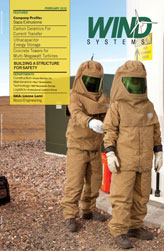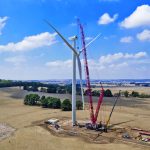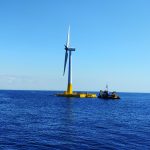As the MW output of modern wind turbines continues to scale upward, the components of these machines increase in size. Maintenance tasks associated with replacing critical components that have historically been handled by one technician are now outside the physical limits of a single person. Though some turbine manufacturers are taking a more proactive role in designing their equipment with maintenance in mind, tasks remain with no alternative but to use brute force in accomplishing them. In an effort to reduce back injuries, project owners are beginning to implement standards that limit the maximum safe lifting weights for technicians, restricting the amount of weight that an employee can personally lift without assistance during the course of his/her duties. This results in a change in work process that not only increases the number of technicians necessary to perform certain tasks, but also reevaluates the uptower activities related to large component handling. Addressing these work conditions is important in order to ensure high productivity, reduced injuries, and longevity of the modern wind technician career.
There are a number of relatively simple and inexpensive ways to positively influence the working environment of a wind technician. Being a proponent of safety programs that endorse continuous awareness of potential health hazards, I understand how human nature should always be considered in reducing the potential of employee injury. Personal protective gear should be properly selected, and its use strictly enforced. Many other ways to influence your safety culture may just require rethinking of procedures or redirecting the procurement practices for safety gear and tooling.
While much has been said about employee behavior and the impact on muscle-related injuries, it is more factual to state that a higher cost return is found by reducing the amount of exposure—or by eliminating the exposure altogether—than it is in specialized training to accommodate an injurious working environment. In a 2008 study by the Journal of Safety Research, researchers found that reducing the exposure to injury-inducing conditions can be up to three times more cost effective than relying on employee behavior or training. Just consider the task of climbing a wind turbine; technicians must be capable of pulling all of their weight up a 90-degree vertical climb to heights often reaching 300 feet or more. The weight of a harness fitted with steel connections, a fall arrest lanyard, and self rescue kit can contribute as much as 25 pounds to the climbing weight of the individual, becoming a significant variable in technician fatigue issues. Replacing this with an equally rated and commercially available PPE that utilizes aluminum connections can reduce the equipment weight by more than 35 percent.
The lifting of tools and components to the nacelle is also an area that can be better thought out. Flexible lifting totes are now available with carry handles on two sides, allowing the bags to be moved by two individuals when the content weight exceeds the limits for one technician. This design also assists the activities uptower, where pulling a tote across the nacelle floor while in a crouched position can lead to muscle strain and injuries. Other more passive approaches can be used to focus on areas of the turbine where injury potential exists. Head knockers, for example, those seemingly innocent low-hanging and very solid structures that leave you seeing stars should be clearly labeled for all to avoid. It doesn’t take a lot of effort to identify where these are located on the turbine, just ask the newly hired technician.
For those who have never experienced the undesirable consequence of a wrench slipping from a bolted connection, you certainly have a surprise in waiting. Musculoskeletal injuries—those related to a skeletal muscle, tendon, ligament, or joints—are one of the most common injuries in the wind industry. Many of these types of injuries are not immediately felt, but they are often the ones that cause pain the next morning. Every move you make voluntarily is performed by a skeletal muscle, so there are many reasons they can become painful. Your posture, the force placed on your muscles, and repetition of tasks all have some part to play in when an injury occurs. For instance, the physical overload of force on your upper body to catch yourself from falling backwards when the wrench slips off the bolt may lead to an unintended muscle or ligament injury. Likewise, the working position of the arm placed relative to a torque wrench handle is an important consideration in avoiding these types of injuries. Awkward postures such as twisting, forward bending, and reaching while exerting high forces on the arms can lead to upper arm and lower back injuries.
We will continue our discussion of safety/maintenance-related challenges in next month’s installment.




































